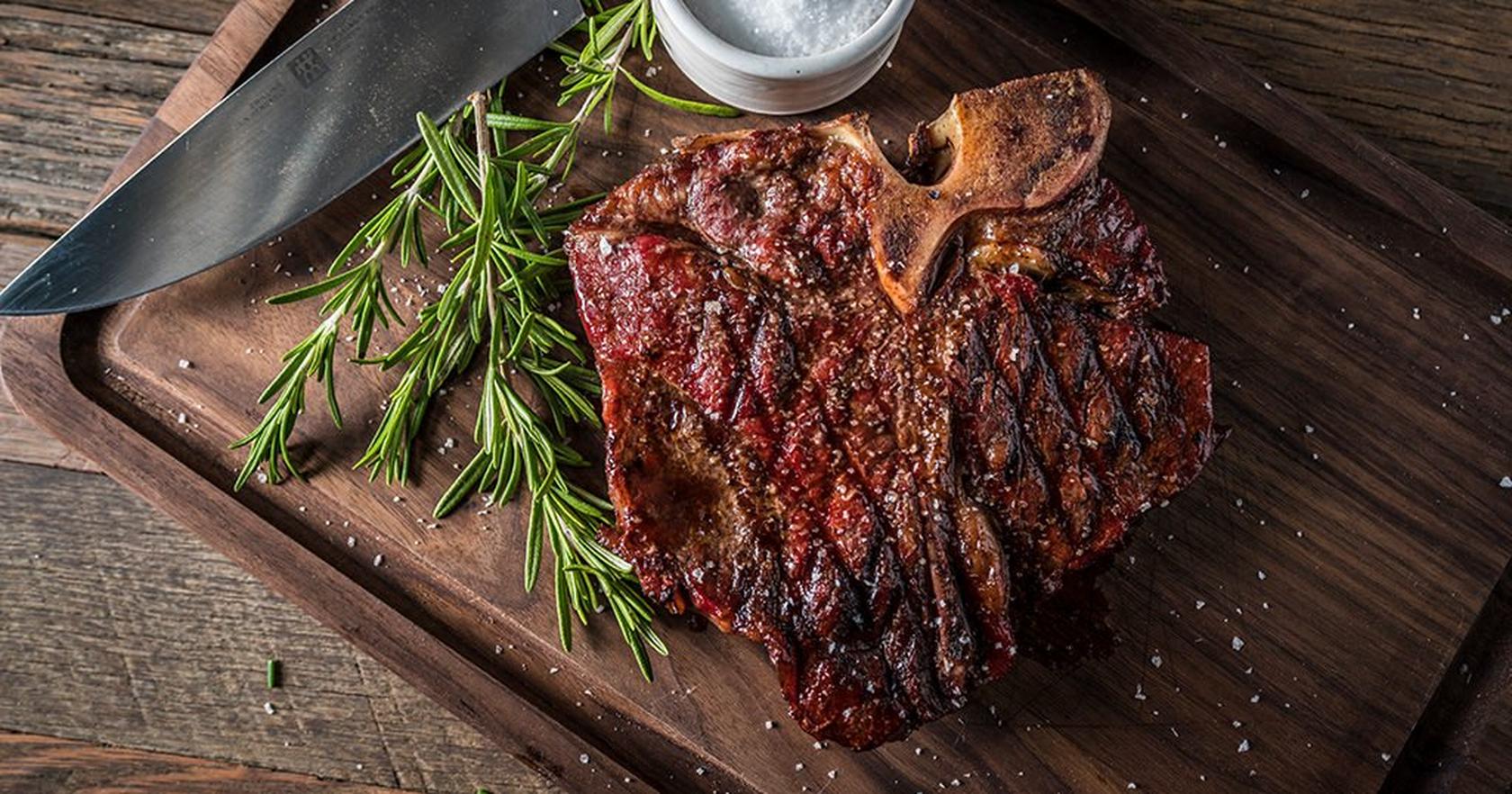
The porterhouse is a massive bone-in cut of steak, often weighing 2 pounds or more. It comes from the loin section of the animal near the spine. A porterhouse steak consists of two sections that have different names when served separately -- New York strip steak and filet mignon. It is almost always lightly seasoned and grilled over high heat.
Primal Cut
- Loin Primal

Porterhouse Cooking Methods and Tips
Typical Cooking Methods
-
Grilling
-
Broiling
-
Reverse Sear
General Cooking Recommendations
Cook porterhouse fast, over high heat, to get browning on the surface without overcooking the tender meat within. Rubs and seasoning can be added, but this flavorful steak doesn't need much help.
While direct grilling or broiling is the most popular method, Porterhouse is also a good candidate for reverse searing. Using this method, you cook the steak slowly until it is nearly medium-rare, then expose it to high heat for the final sear.
How to Cook Porterhouse on Your Traeger
On a Traeger, you can give a porterhouse a hint of smoke. Preheat your Traeger to 225 degrees Fahrenheit, then smoke the steak for 30 minutes. Remove the steak, then turn the Traeger up to 500 degrees. Place the steak back on the grill and cook for 2 to 3 minutes per side, until the internal temperature of the steak reaches 135 degrees for medium-rare.
Porterhouse Internal Temperatures
- For rare, aim for 120-130 °F internally.
- For medium-rare, aim for 130-135 °F internally.
- For medium, aim for 135-145 °F internally.
- For medium-well, aim for 145-155 °F internally.
- For well-done, aim for 155-165 °F internally.
Porterhouse FAQs
Is Porterhouse a Good Cut?
Porterhouse is one of the best steak cuts around. It is a carnivore's delight because of its size, the slightly different textures of its two sections, and the fact that it’s an ideal candidate for cooking medium-rare or even rare.
How Much Does Porterhouse Cost?
A porterhouse will usually go for $15 to $25 per pound, or more for specialty products such as grass-fed, dry-aged, or Wagyu. It is one of the most expensive and sought-after cuts.
Your supermarket may not always carry porterhouse steaks, though any butcher should be able to special order them.
How Do You Know When Porterhouse Is Done?
This cut is done when the internal temperature reaches 135 degrees Fahrenheit for medium-rare. Porterhouse should never be overcooked.
What Is a Porterhouse Best For?
Porterhouse is best for direct grilling or reverse-searing, and for people with an appetite! At 2 pounds or more, this cut can be the main course for at least two people.
What Is the Difference Between Porterhouse and T-Bone Steaks?
The difference between the two steaks is that a porterhouse contains a larger section of filet mignon.
Porterhouse and T-bone steaks are both cut from the short loin section of the animal near the spine. The porterhouse comes from the wider end of the section, and the T-bone from the narrower end.
The two steaks are very similar. Both consist of two sections, divided by a bone. The two sections are the same. One section, when sold as a boneless cut, is the New York strip. The other section, when sold as a boneless cut, is filet mignon.
So you could consider a porterhouse a type of T-bone. What makes a steak a porterhouse is having a large section of the filet mignon. According to USDA regulations, a steak can be called a porterhouse if the filet mignon is at least 1.25 inches across from bone to edge. If the filet mignon section is narrower, the steak must be called a T-bone.
Which Is Better: Porterhouse or T-Bone?
A porterhouse is larger and contains more tender meat than the T-bone. If you like the tenderness of filet mignon, you'll like a porterhouse, which has a larger section of filet than the T-bone. If you prefer the more beefy flavor of the New York strip, however, you may prefer the T-bone, which mostly contains that cut.
Which Is Better: Porterhouse or Ribeye?
A ribeye has a juicier, more tender bite than the porterhouse, because the ribeye has more intramuscular fat. However, the porterhouse contains the most tender piece of meat on the animal (the filet mignon) as well as the beefy flavor of the New York strip.
There's no right answer — ribeye or porterhouse comes down to personal preference.
Can Porterhouse Be Cooked From Frozen?
Yes, if cooked over high heat, the porterhouse can be cooked from frozen. However, for a thick bone-in cut like a porterhouse, it may not be the best idea. Because the internal temperature of the meat may take so long to reach an edible level, you could end up with a charred surface before the steak is safe to eat.
Interesting Facts About Porterhouse
The word "porterhouse" once referred to a type of English pub that sold a dark, hoppy beer called porter -- because laborers known as porters liked it so much.
Porterhouse started to be used to refer to a steak sometime in the mid-1800s in America. No one is exactly sure why it happened. The best guess is that a porter establishment in New York City started serving a large cut of steak like this, and the name stuck.
The cut is also used for the Italian regional delicacy, “bistecca alla fiorentina” or Florentine steak. A traditional dish for at least 500 years, the recipe calls for grilling a T-bone or porterhouse over oak charcoal embers. The meat is usually served rare.
The National Cattlemen's Beef Association identifies the porterhouse with UPC number 1330. You may see this number in the UPC code on the beef package label at the supermarket.
Porterhouse Nutritional Facts
According to the USDA, a porterhouse steak contains 1160 calories, 107 grams of protein, and 78.3 grams of fat.